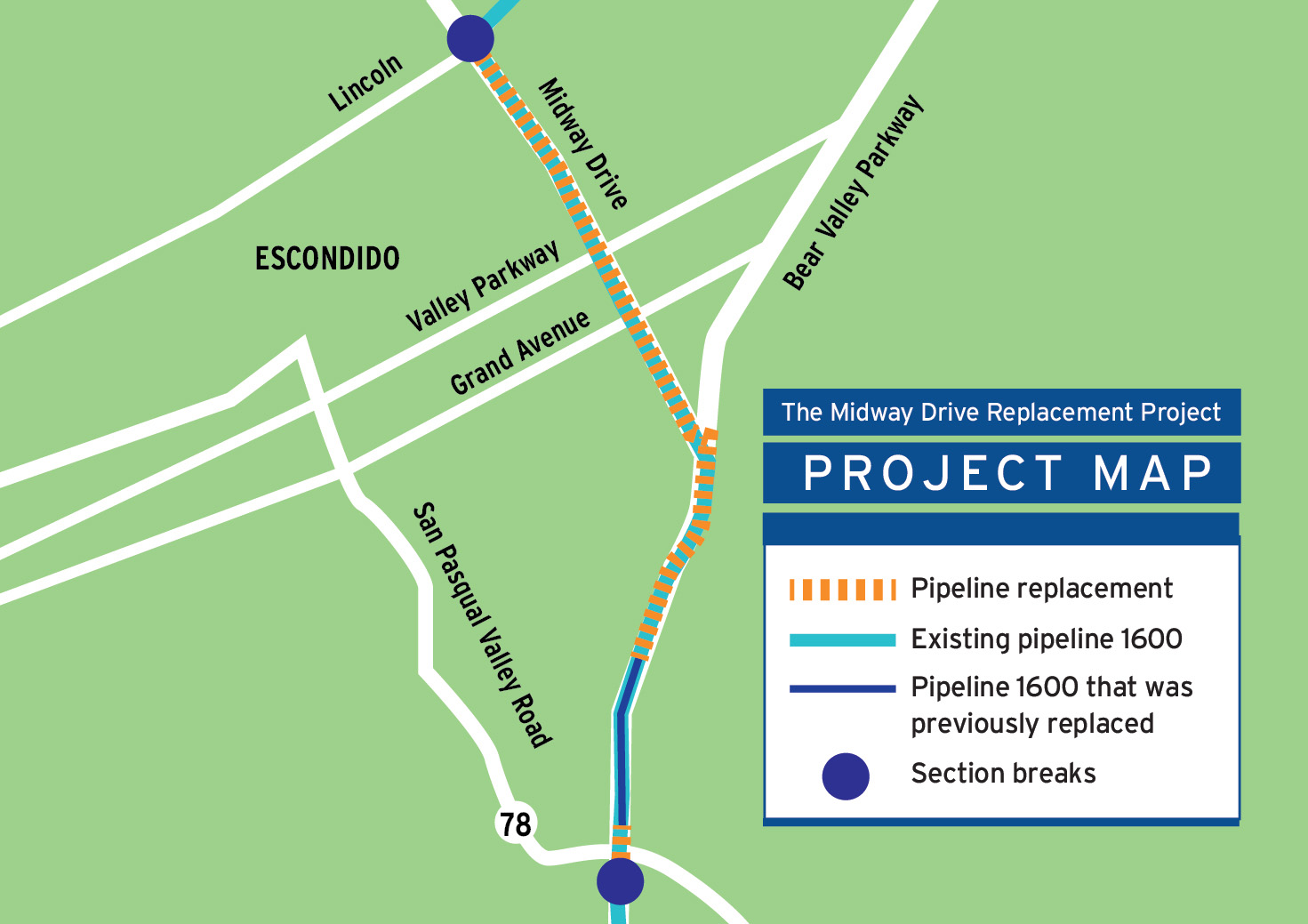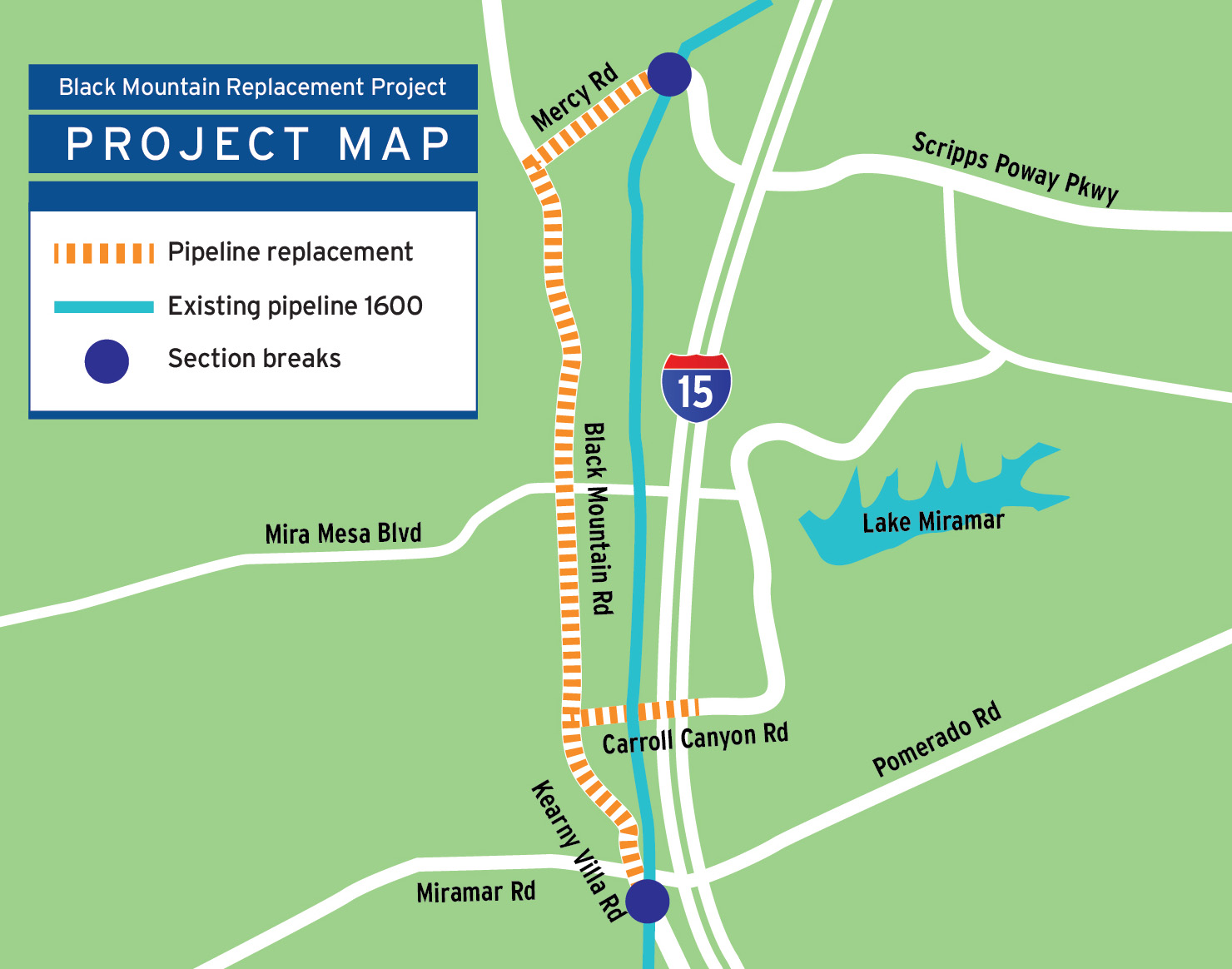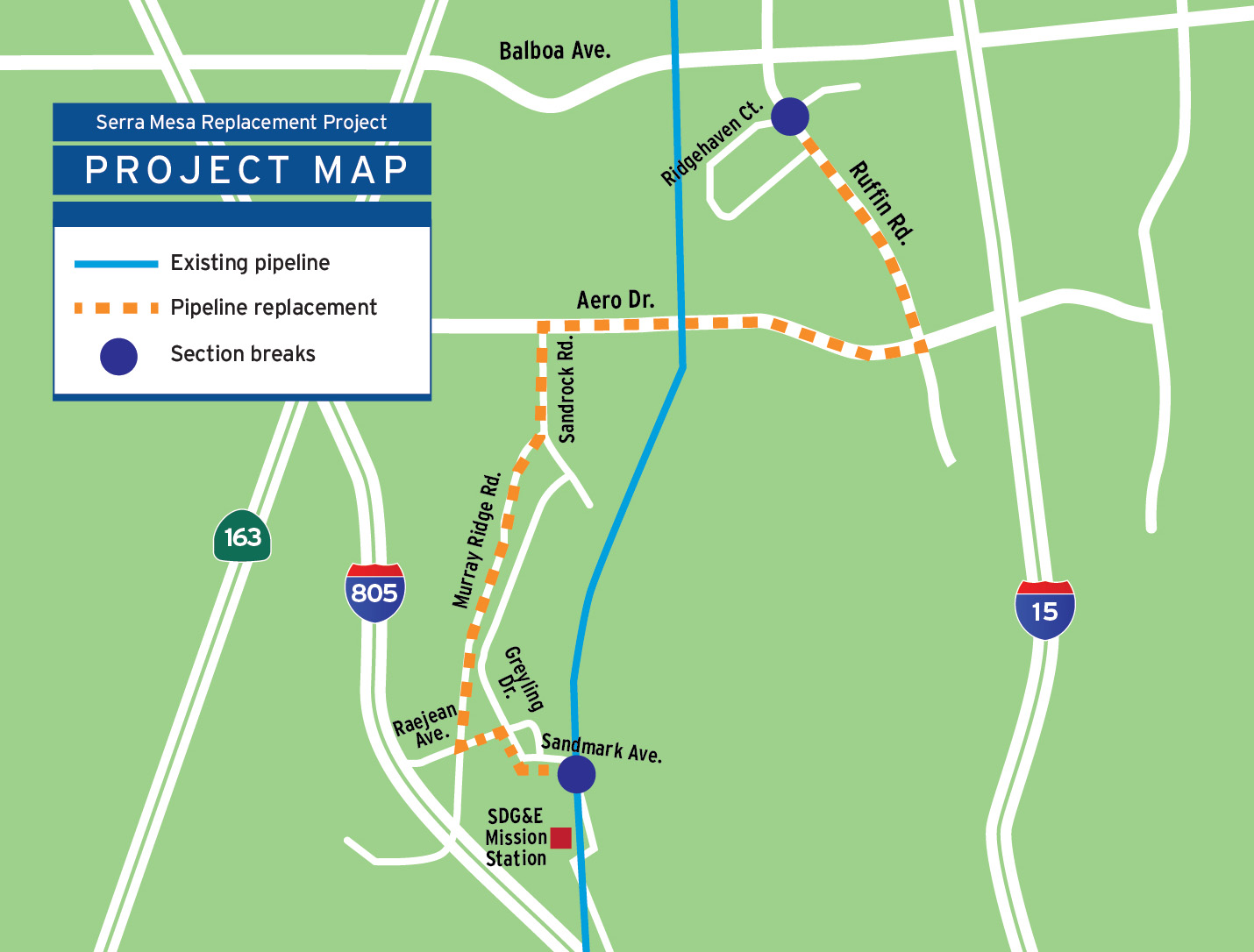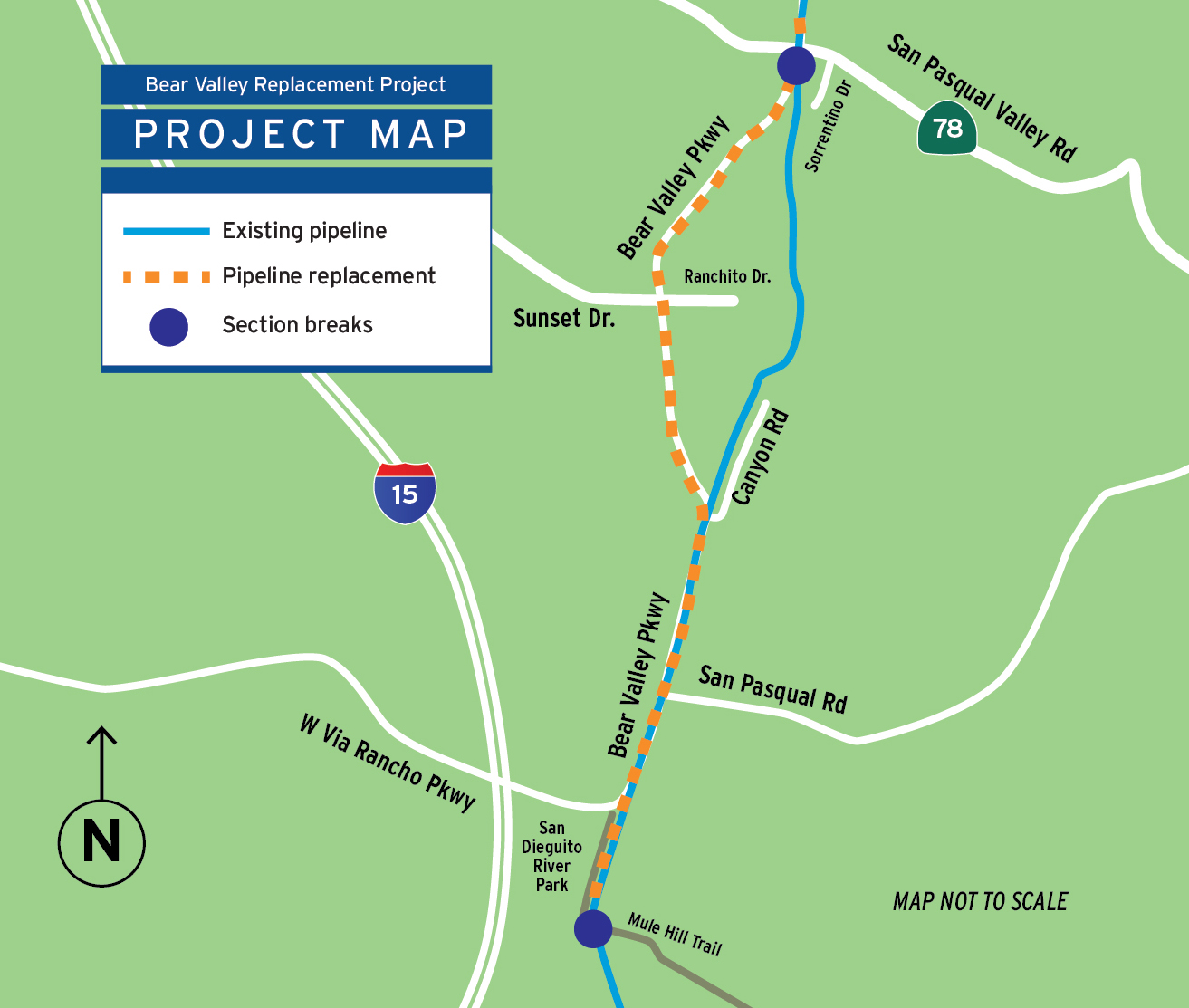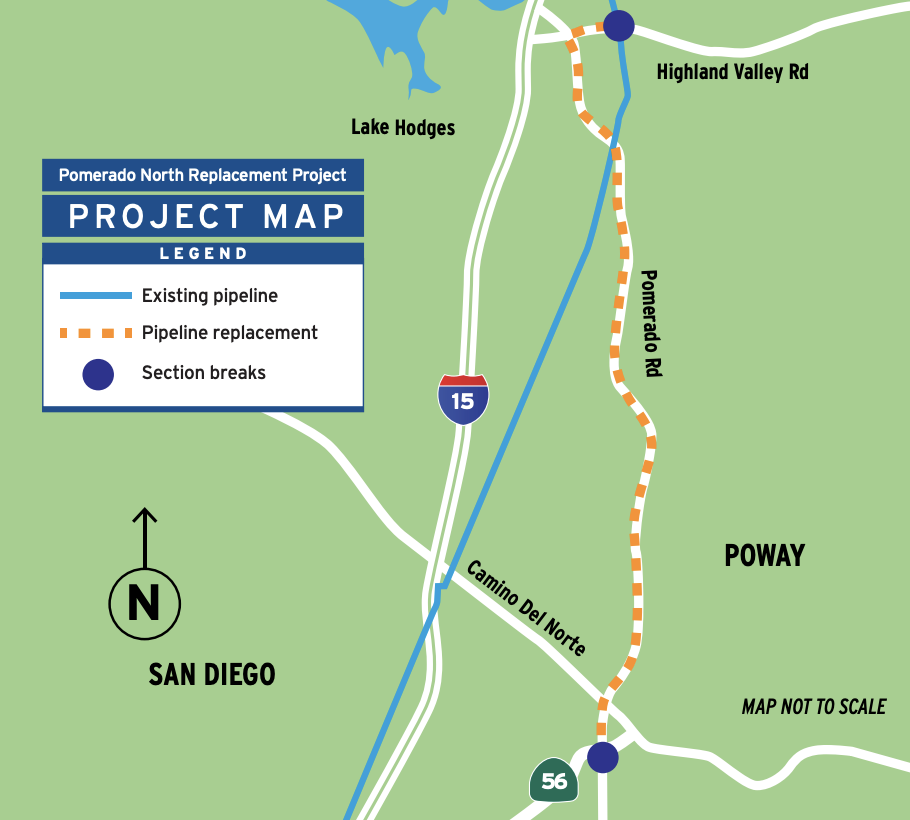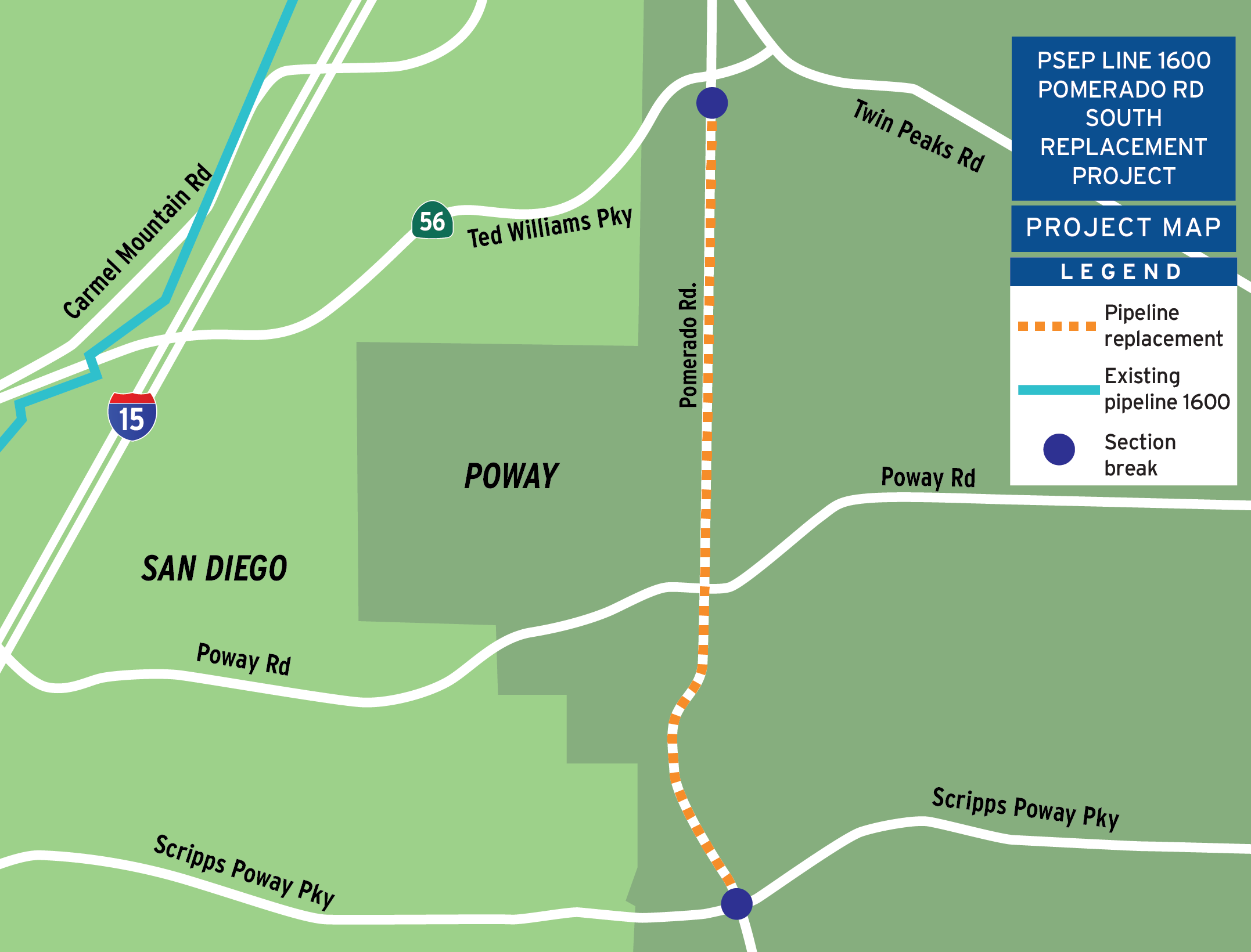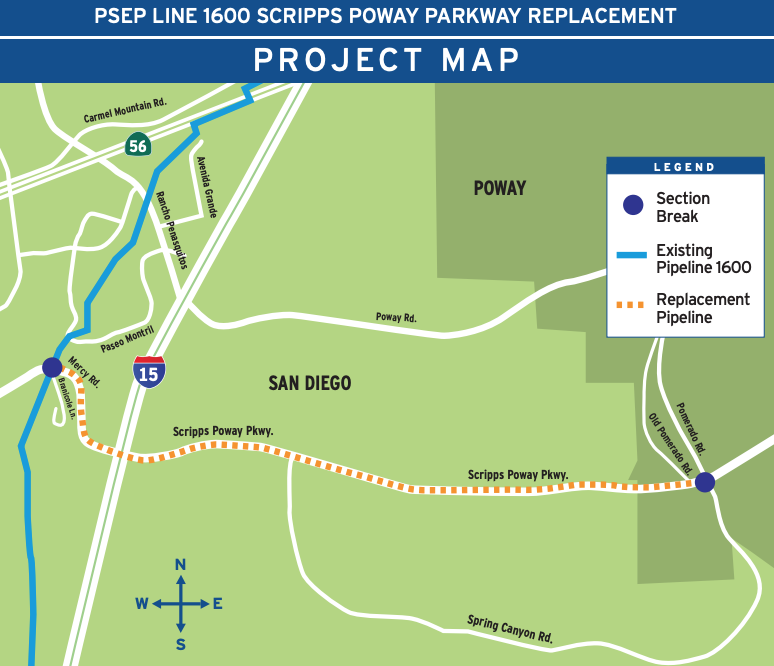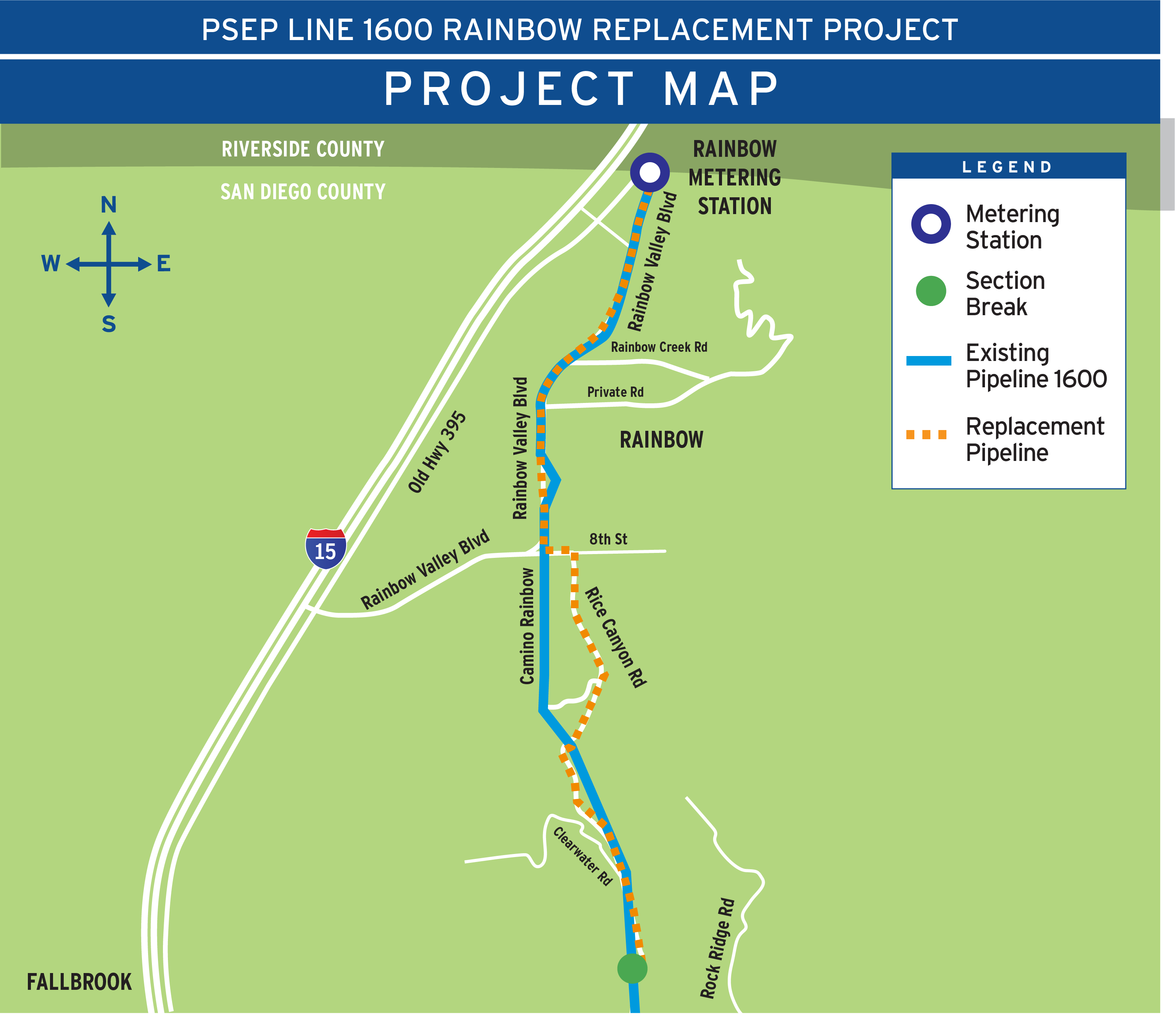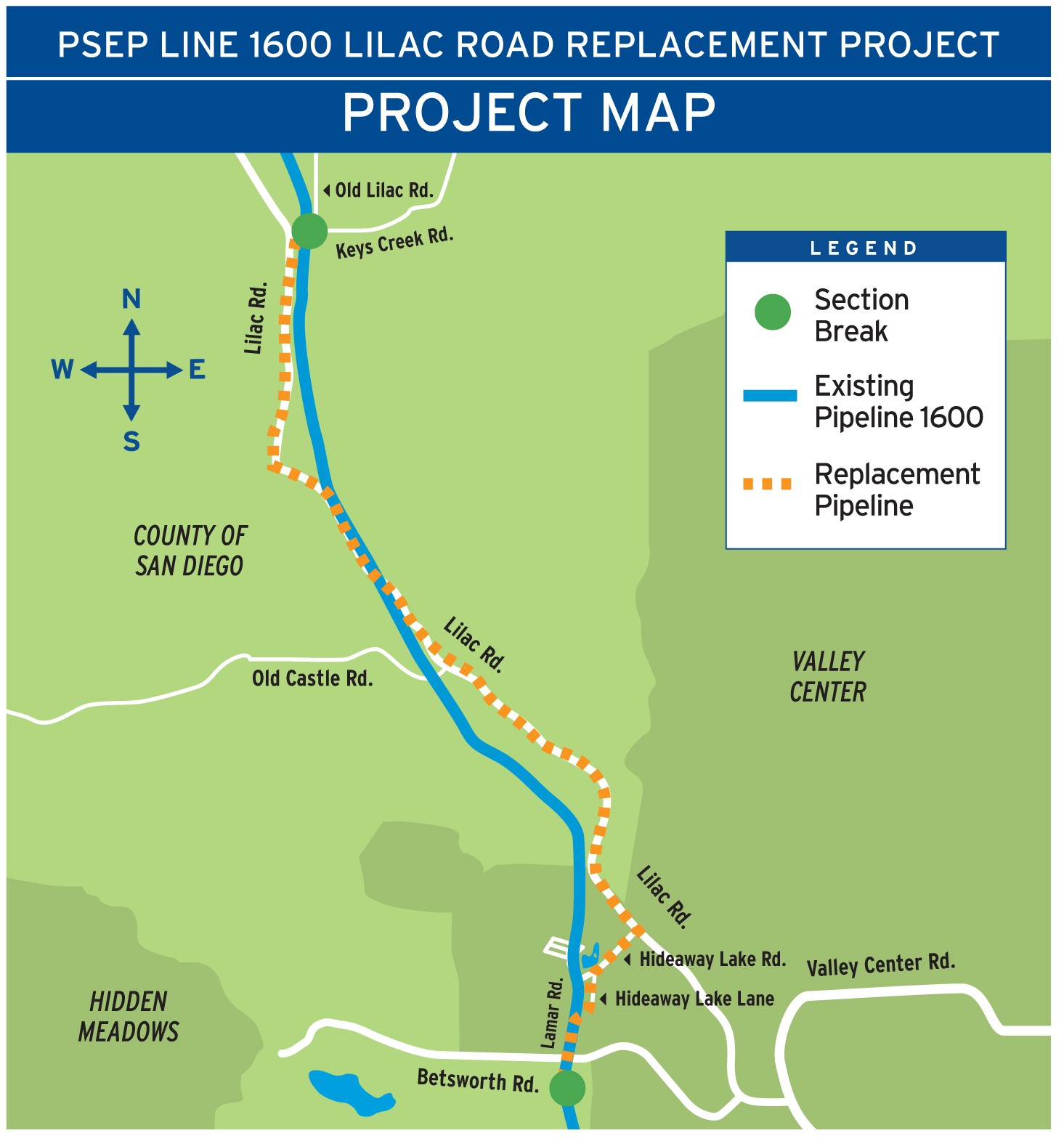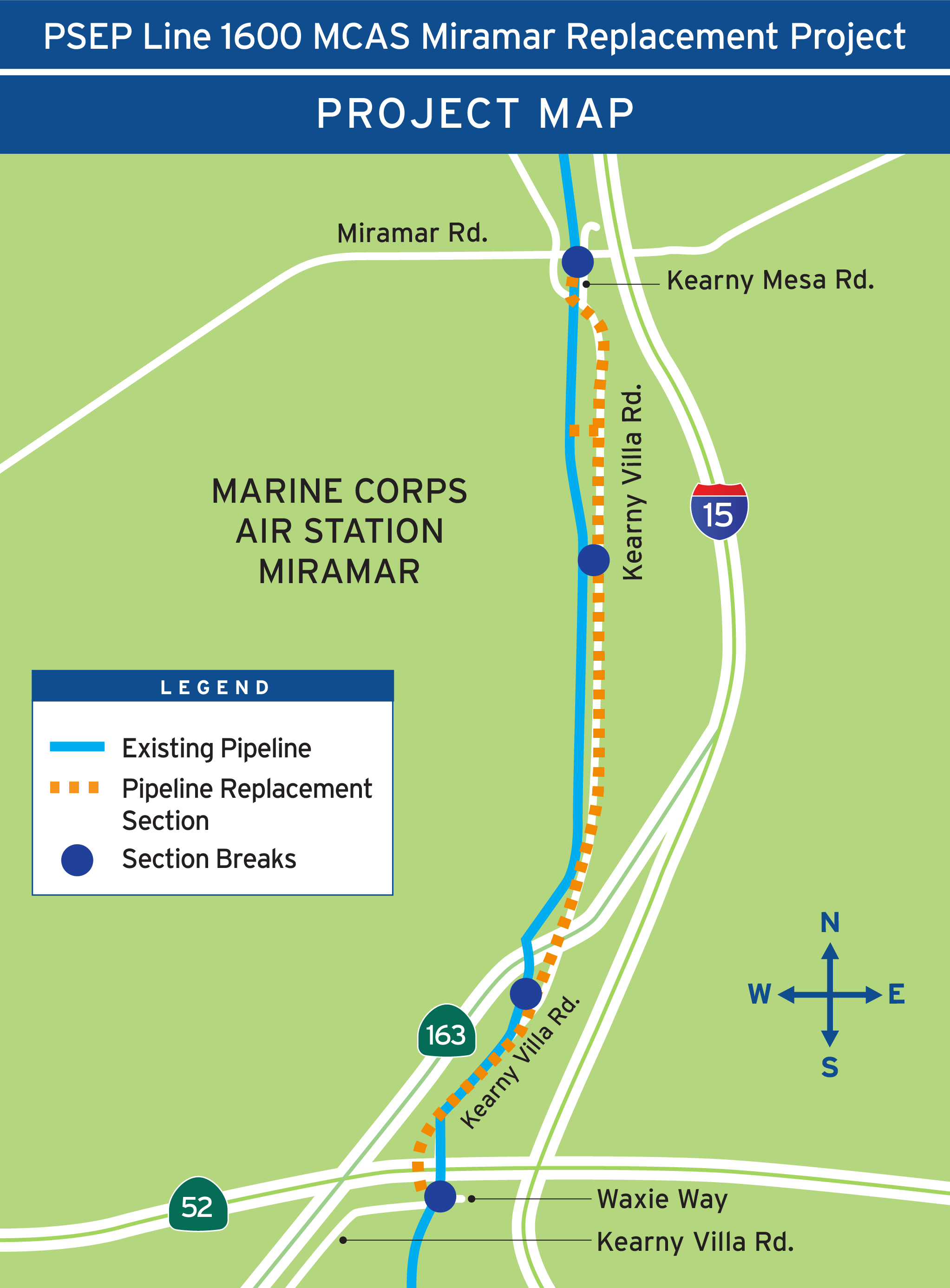
Pipeline Safety Enhancement Plan
Overview
The safety of our customers, employees and the communities we serve is our top priority. This includes the 14,000 miles of natural gas pipeline that we manage. Reflecting that commitment to safety, we construct, operate, and maintain our pipeline system to meet or exceed applicable federal and state regulations and requirements. SDG&E routinely performs various pipeline safety and maintenance tasks, including patrolling, inspecting, testing, repairing and replacing pipelines.
In 2011 the California Public Utilities Commission (CPUC) directed all the investor-owned utilities operating natural gas transmission pipelines in California to each develop an Implementation Plan to achieve the goal of orderly and cost-effectively testing or replacing all natural gas transmission pipelines in their system that have not been strength-tested. SDG&E supports this added measure of pipeline safety ordered by the CPUC, and submitted a Pipeline Safety Enhancement Plan (PSEP) to implement the directives of the Commission. That pipeline safety plan was approved by the CPUC in 2014.
SDG&E’s Pipeline Safety Enhancement Plan (PSEP) identifies various pipeline sections throughout our system that have not been strength-tested, or for which there is no record of a strength test, and slates these pipeline sections to be strength-tested or replaced. The Plan also proposes to upgrade, replace, or retrofit about 21 mainline valves in the system with technology that allows them to be opened or closed remotely by system operators from a central control location, or that automatically shuts off the flow of natural gas in the event of a large pressure drop.
Since 2012, SDG&E has replaced or strength-tested more than 23 miles of natural gas pipe in San Diego County though our PSEP program. These projects have included pipeline testing, retrofitting and replacement activities:
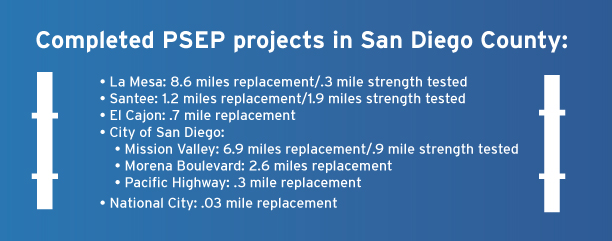
In January 2019, the CPUC’s Safety Enforcement Division (SED) approved SDG&E’s test or replace plan for Line 1600, a 16-inch natural gas transmission pipeline which was not strength tested in 1949 when it was constructed. This next phase of PSEP projects will include 19 separate projects that will take place in the cities of San Diego, Escondido and Poway, as well as the County of San Diego. As part of these projects, approximately 37 miles of existing pipe in more populated areas will be replaced and approximately 13 miles of existing pipe in less populated areas will be strength tested. These next pipeline safety projects will take place starting in 2020:
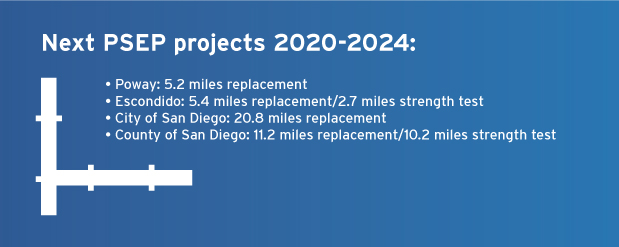
We believe that all customers will benefit from the added testing and safety validation of our transmission system. SDG&E will continue to work with communities and notify customers, and the public, when strength testing or replacement activity is coming to their neighborhood.
Project Schedule:
- Moosa Creek Strength Test Project — Completed April 2023
- Daley Ranch Strength Test Project — Completed April 2023
- Rice Canyon Strength Test Project — Completed June 2024
- Couser Canyon North Strength Test Project — Completed May 2024
- Couser Canyon South Strength Test Project — Completed May 2024
FAQs
Line 1600 is an existing 16-inch diameter natural gas transmission pipeline that starts at the Riverside/San Diego County line and interconnects with other parts of the San Diego natural gas system in Mission Valley. The 50-mile pipeline serves as the primary or sole supply of natural gas for approximately 150,000 customers in eastern Fallbrook, Valley Center, Escondido, Rancho Bernardo, Rancho Penasquitos, Poway, Scripps Ranch, Kearny Mesa and Serra Mesa.
SDG&E will be upgrading this pipeline over the next several years to enhance the safety of the natural gas transmission system and meet new state laws and regulations.
Line 1600 was constructed in 1949 with materials and construction practices that aren’t considered state-of-the art by today’s safety standards. Line 1600 wasn’t strength tested prior to being placed into service, as this practice wasn’t mandated nor the industry norm prior to 1955.
In 2011, following the pipeline rupture in San Bruno in 2010, legislation was adopted that directed all natural gas operators in California to develop plans to enhance the safety of the natural gas transmission system. SDG&E’s plan, the “Pipeline Safety Enhancement Plan” (PSEP), was approved in 2014, and since that time, we’ve upgraded and modernized more than 23 miles of natural gas pipelines in San Diego County.
Because Line 1600 provides a critical source of energy to customers in the region, extra review was taken to determine the best way to satisfy California pipeline safety requirements, while maintaining reliable service to our customers. In January 2019, the CPUC approved SDG&E’s plan to upgrade Line 1600 and further enhance the safety of our pipeline system.
The safety of our customers, employees and the communities we serve is our top priority. These 19 separate safety enhancement projects will take place in the cities of San Diego, Escondido and Poway, as well as the County of San Diego.
Through these projects, SDG&E will replace approximately 37 miles of existing pipe in more populated areas and strength test approximately 13 miles of existing pipe in less populated areas.
These pipeline safety projects will be completed between 2020-2024:
- Poway: 5.2 miles replacement
- Escondido: 5.4 miles replacement/2.7 miles strength test
- City of San Diego: 20.8 miles replacement
- County of San Diego: 11.2 miles replacement/10.2 miles strength test
The replacement pipeline will incorporate new safety features such as improved and thicker steel, a warning mesh placed above the pipeline to prevent accidental excavations, automatic shut-off valves and new fiber optic technology to detect ground disturbances that could impact pipeline integrity.
Because the safety enhancements will be achieved through completion of 19 independent construction projects, construction activities are anticipated to only impact a community for a short amount of time. The majority of the projects are approximately three miles or less. Actual construction time is projected to take approximately six weeks per mile for each project. Traffic flow will be maintained at all times.
Most areas near Line 1600 are heavily developed so most of the replacement pipeline will be installed in nearby streets. This is done to avoid construction impacts on private property and so that our work can continue without interrupting the flow of natural gas through the original pipeline. Before each new pipeline segment is placed into service, we conduct a strength test to verify the integrity of the new section.
We believe that all customers will benefit from the added testing and safety validation of our transmission system. SDG&E will continue to work with communities and notify customers and the public, when strength testing or replacement activity is coming to their neighborhood.
The estimated $619 million cost of the 19 projects will be shared by both SDG&E and SoCalGas customers since this is a backbone transmission project which benefits all customers. A typical SDG&E residential gas customer who uses the system-wide average of 23 therms per month would see an average monthly increase of approximately 0.6 percent or 25 cents on a typical bill, from the current $41.76 per month to $42.01 per month. Business customers would see an average monthly increase of about 1.0 percent. The CPUC will determine the final authorized project costs through a separate regulatory process once all projects are placed into service by 2024.
Natural gas is a primary source of energy in San Diego County. Upgrading Line 1600 will enhance the safety and reliability of the pipeline and our entire system so that we may continue to meet or exceed all federal and state regulations and requirements and provide reliable service to our customers.
If you have any questions or concerns, please call us at 1-866-382-0886.
Pipeline Replacement
Sometimes pipelines are replaced to meet expanding customer and/or gas system needs as well as to accommodate infrastructure improvement projects of cities, counties and state agencies.
Usually a new pipeline is installed alongside the existing pipeline to be replaced. This is done so that our work can continue without interrupting the flow of natural gas through the original pipeline. Before the new pipeline is brought into service, we conduct a hydrostatic strength test to verify the integrity of the new section.
Pipeline Valve Replacement and Retrofitting
Valves are mechanical devices that control the flow of natural gas through the pipelines. These valves can be opened or closed in order to control gas flow to a pipeline segment. This is needed for maintenance, testing or replacement of that segment. These valves also give our operators greater flexibility and control that can mean shorter response times in the event of an emergency.
Strength Testing
During our testing activities, we test a pipeline section to make sure it’s reliable. Strength testing is a common method that we use to assess our pipeline. We fill the pipeline segment with water and apply above normal pressure to the interior area being tested. After a holding the increased pressure for at least eight hours without any leaks, the test is complete and the pipeline segment is reconnected and returned to service. If the test shows a rupture or leak, the pipeline section will be repaired or replaced and a second strength test is conducted before returning the pipe to service.
Construction Area
One of our top priorities is providing you with safe and reliable energy. To do this, we make improvements to our system. We have a plan underway to enhance our natural gas pipeline throughout our service area.
What to Expect
We’ll work as quickly and safely as possible and make every effort to minimize disruptions. Our work may take several weeks to complete and varies depending on a number of factors, but in general here’s what you may experience:
- Lane reductions, closures or detours
- Temporary delays on surface streets
- Heavy equipment such as trucks and machinery on the streets
- Excavation sites
- Temporary “No Parking” signs on streets
- Work-related dust or noise
- Occasional odor of natural gas
The odor of natural gas
At times, you may smell the odor of natural gas and hear a loud, steady noise as we vent natural gas from the pipeline using safe and common techniques. Although this is normal when crews are working, we encourage anyone who has concerns about the smell of gas to call us from a safe location at 1-866-382-0886. We’re available 24 hours a day, seven days a week.
Although not anticipated, our work may require us to shut-off natural gas service for safety purposes. If this is necessary, we’ll contact you in advance to make sure you’re prepared. We appreciate the cooperation and patience of our customers and the communities we serve as we work to enhance the safety of our natural gas pipeline system.
Regulatory Process
The California Public Utilities Commission (CPUC) has required all California investor-owned utilities to develop Pipeline Safety Enhancement Plans. Our plan meets the following objectives:
- Enhance public safety
- Comply with the CPUC’s regulatory requirements
- Minimize customer impacts
- Maximize the cost effectiveness of any infrastructure investments
SDG&E filed its plan with the CPUC in August, 2011, and it was approved in June 2014.
For More Information
If you have any questions or concerns during or after construction, please call 1-866-382-0886.
